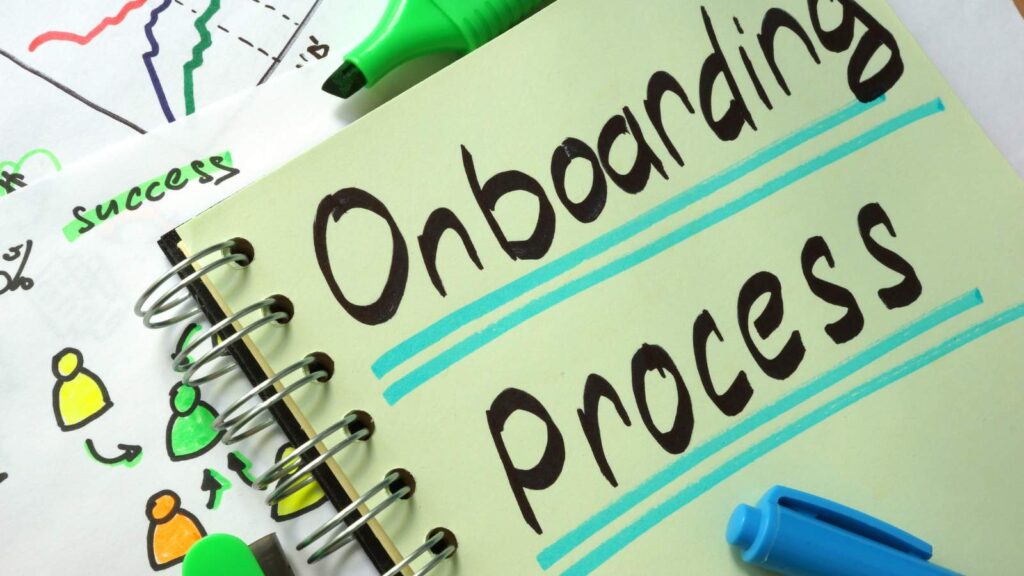The onboarding process has become a crucial phase for integrating new employees into an organization effectively. Onboarding is more than just a single event; it’s a comprehensive process that begins right after the recruitment phase and extends through the initial months of employment, culminating in specific on-the-job training. This guide delves into the nuances of onboarding, emphasizing its significance, components, and best practices, with a focus on production employees.
Table of Contents
ToggleUnderstanding Onboarding
Onboarding is the bridge between the recruitment process and an employee’s journey within an organization. Once the recruitment phase concludes—having identified and offered the position to the candidate—the onboarding process commences. This phase is critical as it sets the tone for the employee’s tenure at the company, influencing their productivity, engagement, and long-term retention.
The Core of Onboarding
At its core, onboarding is designed to equip new hires with the necessary tools, knowledge, and connections to become productive and integrated members of the organization. It encompasses various activities including orientation sessions, completion of administrative procedures, introduction to the company’s culture and expectations, and initial training programs.
Beyond Onboarding: On-the-Job Training
After the initial onboarding phase, employees typically transition into more specialized on-the-job training programs. For production employees, this is where methodologies like Training Within Industry (TWI) Job Instructions (JI) become invaluable. TWI JI is a foundational methodology designed to help supervisors and trainers develop a workforce that is skilled, versatile, and efficient. Originating from the need to rapidly train workers in various industries during World War II, TWI JI has since evolved into a universal approach, emphasizing simplicity, consistency, and effectiveness in on-the-job training.
The Four-Step Method of TWI JI
TWI JI is structured around a four-step method that ensures training is conducted systematically, resulting in quick mastery and retention of skills. These steps are:
- Prepare the Worker: The initial step involves preparing the employee for training by putting them at ease, explaining the job’s importance, and ensuring they understand the objective of the training. It sets the stage for a conducive learning environment, where the trainee is mentally ready and receptive.
- Present the Operation: In this step, the trainer demonstrates the task at a standard pace, explaining each key point and the reasons behind them. The demonstration is critical, as it provides the trainee with a clear model of what success looks like, breaking down complex operations into manageable parts.
- Try Out Performance: Here, the trainee performs the task under the trainer’s supervision, allowing them to apply what they’ve learned in a controlled setting. The trainer corrects mistakes and reinforces correct practices, ensuring the trainee understands each step’s nuances and the operation as a whole.
- Follow Up: The final step involves the trainer following up with the trainee, providing additional practice, gradually reducing supervision as the trainee becomes more proficient, and encouraging questions to clarify doubts. This step ensures the trainee is competent and confident in performing the task independently.
The Role of TWI JI in Onboarding
In the context of onboarding, especially for production employees, TWI JI plays a pivotal role in ensuring new hires are not only introduced to their tasks but are also equipped to perform them efficiently and safely. By applying the TWI JI method, organizations can:
- Reduce Learning Time: The structured approach of TWI JI helps new employees learn their roles faster, enabling them to contribute to production efforts in a shorter time.
- Improve Quality: With a focus on teaching the “one best way” to perform tasks, TWI JI enhances the quality of work by reducing variability in how tasks are performed.
- Increase Safety: By emphasizing key points and reasons behind each step, TWI JI ensures that safety protocols are integral to job instructions, thereby minimizing workplace accidents.
- Foster a Learning Culture: Implementing TWI JI during onboarding signals to new hires that the organization values continuous learning and improvement, setting the tone for their development journey within the company.
Best Practices for Implementing TWI JI
To effectively implement TWI JI in onboarding, organizations should:
- Customize Training to the Job: While TWI JI provides a framework, it’s important to tailor the training content to the specific tasks and context of the job.
- Train the Trainers: Ensure that those who are responsible for onboarding and training are themselves trained in the TWI JI method to maintain consistency and effectiveness.
- Incorporate Feedback Loops: Regularly seek feedback from both trainers and trainees to refine and improve the training process.
- Integrate with Other Onboarding Elements: TWI JI should be part of a comprehensive onboarding program that covers company culture, policies, and expectations, providing a holistic start to the employee’s journey.
Conclusion
Training Within Industry’s Job Instruction method is more than just a training technique; it’s a strategy that aligns with the broader goals of onboarding by ensuring new hires are quickly, efficiently, and safely brought up to speed. By adopting TWI JI, organizations can significantly enhance their onboarding process, leading to a more competent, confident, and engaged workforce.
Onboarding Production Employees: Key Topics
When onboarding production employees, it’s essential to cover specific topics that align with their roles and the organization’s operational excellence goals. These include:
Health, Safety, and Environment (HSE)
New hires must understand the company’s HSE policies and procedures to ensure a safe working environment. This includes training on personal protective equipment (PPE), emergency response actions, and workplace safety protocols.
Quality
Training on quality standards and controls is crucial. Employees should learn about the company’s commitment to quality, how it’s measured, and their role in maintaining it through their work processes.
Lean and Continuous Improvement (CI)
Introducing concepts of lean manufacturing and continuous improvement early on helps new hires understand their part in streamlining operations, reducing waste, and enhancing productivity.
Standardization
Standardization ensures consistency and efficiency. Employees should learn the importance of following standard operating procedures (SOPs) and how these procedures contribute to the overall success of the production line.
Examples of Onboarding: The Good and the Bad
Good Examples of Onboarding
- Interactive and Engaging Sessions: Companies that use a mix of interactive e-learning modules, hands-on training, and mentorship programs ensure a deeper understanding and engagement from the new hire.
- Clear Expectations and Goals: Organizations that set clear, achievable goals for new hires during their onboarding process often see higher levels of early engagement and job satisfaction.
Bad Examples of Onboarding
- Information Overload: Bombarding new hires with too much information in a short period can lead to confusion and disengagement.
- Lack of Follow-Up: Failing to provide ongoing support and check-ins after the initial onboarding phase can leave new employees feeling neglected and unsure about their performance and role within the company.
Conclusion
Effective onboarding is a critical investment in the future of new hires and the organization itself. By focusing on key areas such as HSE, quality, lean and CI, and standardization, and employing effective training methodologies like TWI JI, companies can ensure their onboarding process supports both immediate integration and long-term success for production employees. Remember, the goal of onboarding is not just to introduce the employee to the company but to integrate them into the fabric of the organization, aligning their personal goals with the company’s mission and values.





